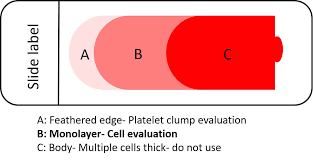Which of the following criteria is acceptable in determining the quality of a peripheral blood smear?
Covers a quarter of the slide
A well-defined edge
Covers the entire slide
A feathered edge
The Correct Answer is D
Choice A reason:
Covering a quarter of the slide is not an acceptable criterion for the quality of a peripheral blood smear. The smear should be spread across the slide in a manner that allows for proper examination under a microscope, and covering only a quarter of the slide would not provide enough area for an adequate assessment.
Choice B reason:
Having a well-defined edge is not specifically indicative of the quality of a peripheral blood smear. While the edges should be clean to allow for clear viewing of the cells at the margins, the quality is more accurately determined by the distribution and integrity of the cells on the slide.
Choice C reason:
Covering the entire slide is also not a criterion for a quality peripheral blood smear. In fact, if the blood covers the entire slide, it may be too thick to allow for proper cell differentiation and examination. A proper smear should have a gradient of cell distribution, ending with a feathered edge.
Choice D reason:
A feathered edge is the correct criterion for a quality peripheral blood smear. The feathered edge is the thinnest part of the smear and is where the cells are ideally distributed in a single layer, which is optimal for microscopic examination. This allows for the best visualization of cell morphology and is essential for accurate diagnosis.

Nursing Test Bank
Naxlex Comprehensive Predictor Exams
Related Questions
Correct Answer is B
Explanation
Choice A reason:
The date of birth is a common identifier, but it is not unique to an individual, as multiple patients may share the same birth date. While it is useful in conjunction with other identifiers, on its own, it does not provide a definitive identification.
Choice B reason:
The record number, often referred to as the medical record number, is a unique identifier assigned to each patient within a healthcare system. It is used to track patient information across different visits and services, making it the most reliable standalone identifier if the patient's name is not available.
Choice C reason:
An address can change over time and may not be unique, especially in large apartment buildings or for patients who are homeless or transient. It is also not specific enough to reliably identify a patient, as multiple individuals can reside at the same address.
Choice D reason:
The social security number is a unique identifier, but due to privacy concerns and the risk of identity theft, it is not the preferred method for patient identification in healthcare settings. Additionally, not all patients may have a social security number, such as non-residents or newborns.
Correct Answer is A
Explanation
Choice A reason:
Expired tubes may lose their vacuum, which is necessary to draw the correct volume of blood into the tube. The vacuum in blood collection tubes ensures that the correct amount of blood is drawn. If the vacuum is lost, the blood will not be drawn into the tube properly, which can lead to underfilling and affect the test results.
Choice B reason:
Hemoconcentration refers to an increase in the concentration of cells and solids in the blood, usually because of a loss of plasma. While this can occur due to prolonged tourniquet application or dehydration, it is not directly caused by the use of expired tubes.
Choice C reason:
Hemolysis is the destruction of red blood cells, which can release hemoglobin and other intracellular components into the plasma. It can be caused by physical damage, such as from a needle during blood draw, but is not a consequence of using expired tubes. However, if an expired tube causes improper blood draw due to loss of vacuum, it could indirectly lead to hemolysis due to multiple attempts to draw blood.
Choice D reason:
An elevation of the red blood cell count would not be directly caused by using expired tubes. The red blood cell count is determined by the body's production and destruction of red blood cells, not by the collection method or equipment used.
Whether you are a student looking to ace your exams or a practicing nurse seeking to enhance your expertise , our nursing education contents will empower you with the confidence and competence to make a difference in the lives of patients and become a respected leader in the healthcare field.
Visit Naxlex, invest in your future and unlock endless possibilities with our unparalleled nursing education contents today
Report Wrong Answer on the Current Question
Do you disagree with the answer? If yes, what is your expected answer? Explain.
Kindly be descriptive with the issue you are facing.
